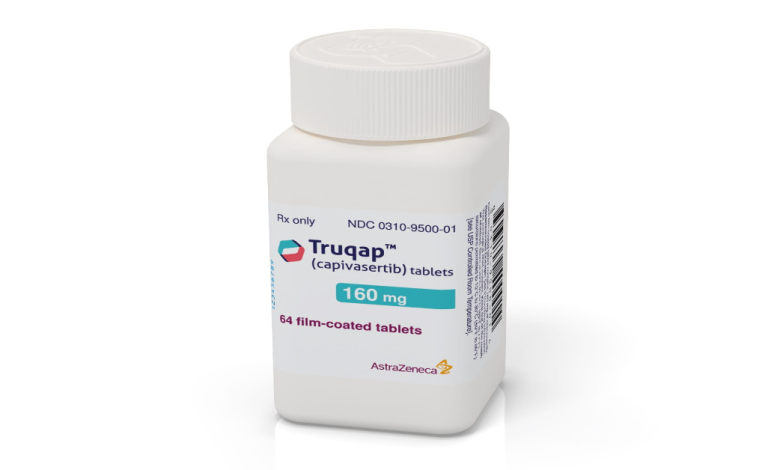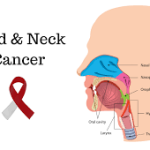FDA Approves Truqap (capivasertib) plus Faslodex for Patients with Advanced HR-Positive Breast Cancer

AstraZeneca’s Truqap (capivasertib) in combination with Faslodex (fulvestrant) has been approved in the US for the treatment of adult patients with hormone receptor (HR)-positive, HER2-negative locally advanced or metastatic breast cancer with one or more biomarker alterations (PIK3CA, AKT1 or PTEN). Eligible patients will have progressed on at least one endocrine-based regimen in the metastatic setting or experienced recurrence on or within 12 months of completing adjuvant therapy.
The approval by the Food and Drug Administration (FDA) was based on the results from the CAPItello-291 Phase III trial published earlier this year in The New England Journal of Medicine.1 In the trial, Truqap in combination with Faslodex reduced the risk of disease progression or death by 50% versus Faslodex alone in patients with tumours harbouring PI3K/AKT pathway biomarker alterations (based on hazard ratio of 0.50, 95% confidence interval 0.38-0.65; p=<0.001; median progression-free survival (PFS) 7.3 versus 3.1 months).
Breast cancer is the most common cancer and one of the leading causes of cancer-related death worldwide.2 HR-positive breast cancer (expressing estrogen or progesterone receptors, or both), is the most common subtype, with more than 65% of tumours considered HR-positive and HER2-low or HER2-negative.3 Collectively,mutations inPIK3CA, AKT1 and alterations in PTEN occur frequently, affecting up to 50% of patients with advanced HR-positive breast cancer.4-6 Endocrine therapies are widely used in this setting, but many patients develop resistance to 1st-line cyclin-dependent kinase (CDK) 4/6 inhibitors and estrogen receptor-targeting therapies, underscoring the need for additional endocrine therapy-based options.7
Komal Jhaveri, MD, Medical Oncologist, Memorial Sloan Kettering Cancer Center (MSK), US, said: “Patients with advanced HR-positive breast cancer typically experience tumour progression or resistance with widely used first-line endocrine therapies and there is an urgent need to extend the effectiveness of these approaches. The combination of capivasertib and fulvestrant, a first-of-its-kind combination, provides a much-needed new treatment option for up to half of patients in this setting with these specific biomarkers, offering the potential to delay disease progression and provide more time with their disease under control.”
Dave Fredrickson, Executive Vice President, Oncology Business Unit, AstraZeneca, said: “The rapid US approval of Truqap reinforces the important role of the PI3K/AKT pathway in HR-positive breast cancer and the critical need to test patients at the time of diagnosis, as up to fifty per cent have tumours with these alterations. As a first-in-class medicine, this approval provides a critical new option for patients in the US with this specific type of disease and we look forward to bringing Truqap to the many breast cancer patients who can benefit across the globe.”
In the CAPItello-291 trial, the safety profile of Truqap plus Faslodex was similar to that observed in previous trials evaluating this combination.1
Concurrently with this approval, the FDA also approved a companion diagnostic test to detect relevant alterations (PIK3CA, AKT1 and PTEN).
The US regulatory submission was granted Priority Review and reviewed under Project Orbis, which provides a framework for concurrent submission and review of oncology medicines among participating international partners. As part of Project Orbis, Truqap plus Faslodex is also under review by regulatory authorities in Australia, Brazil, Canada, Israel, Singapore, Switzerland and the UK.
Regulatory applications for Truqap in combination with Faslodex are also currently under review in China, the European Union, Japan and several other countries.
Financial considerations
Following this approval in the US, Astex Therapeutics is eligible to receive a milestone payment from AstraZeneca on first commercial sale of the drug in the US as well as royalties on future sales in line with the agreement between the two companies.
HR-positive breast cancer
Breast cancer is the most common cancer and one of the leading causes of cancer-related death worldwide.2 More than two million patients were diagnosed with breast cancer in 2020, with nearly 685,000 deaths globally.2 In the US, more than 290,000 patients are expected to be diagnosed in 2023, with more than 43,000 deaths.8
HR-positive breast cancer (expressing estrogen or progesterone receptors, or both), is the most common subtype of breast cancer with more than 65% of tumours considered HR-positive and HER2-low or HER2-negative.3 Collectively, mutations inPIK3CA, AKT1 and alterations in PTEN occur frequently, affecting up to 50% of patients with advanced HR-positive breast cancer.4-6
The growth of HR-positive breast cancer cells is often driven by estrogen receptors (ER),andendocrine therapies that target ER-driven disease are widely used as first-line treatment in the advanced setting, and often paired with CDK4/6 inhibitors.7,9,10 However, resistance to CDK4/6 inhibitors and current endocrine therapies develops in many patients with advanced disease.9 Once this occurs, treatment options are limited– with chemotherapy being the current standard of care – and survival rates are low with 30% of patients anticipated to live beyond five years after diagnosis.3,9,11
The optimisation of endocrine therapy and overcoming resistance to enable patients to continue benefiting from these treatments, as well as identifying new therapies for those who are less likely to benefit, are active areas of focus for breast cancer research.
CAPItello-291
CAPItello-291 is a Phase III, double-blind, randomised trial evaluating the efficacy of Truqap in combination with Faslodex versus placebo plus Faslodex for the treatment of locally advanced (inoperable) or metastatic HR-positive, HER2-low or negative (immunohistochemistry (IHC) 0 or 1+, or IHC 2+/in-situ hybridisation (ISH)-negative) breast cancer.
The global trial enrolled 708 adult patients with histologically confirmed HR-positive, HER2-low or negative breast cancer whose disease has recurred or progressed during or after aromatase inhibitor therapy, with or without a CDK4/6 inhibitor, and up to one line of chemotherapy for advanced disease. The trial has dual primary endpoints of PFS in the overall patient population and in a population of patients whose tumours have qualifying alterations in the PI3K/AKT pathway (PIK3CA, AKT1 or PTEN genes). In the trial, approximately 40% of tumours had these alterations and approximately 70% of patients received a prior CDK4/6 inhibitor.
Truqap
Truqap (capivasertib) is a first-in-class, potent, adenosine triphosphate (ATP)-competitive inhibitor of all three AKT isoforms (AKT1/2/3). Truqap 400mg is administered twice daily according to an intermittent dosing schedule of four days on and three days off. This was chosen in early phase trials based on tolerability and the degree of target inhibition.
Truqap is currently being evaluated in Phase III trials for the treatment of multiple subtypes of breast cancer and in other tumour types either as monotherapy or in combination with established treatments. The ongoing clinical research programme is focused on tumours reliant on signalling via the PI3K/AKT pathway, and in tumours harbouring biomarker alterations in this pathway.
Truqap was discovered by AstraZeneca subsequent to a collaboration with Astex Therapeutics (and its collaboration with the Institute of Cancer Research and Cancer Research Technology Limited).
Faslodex
Faslodex is an endocrine therapy indicated for the treatment of estrogen receptor-positive, locally advanced or metastatic breast cancer in postmenopausal women not previously treated with endocrine therapy, or with disease relapse on or after adjuvant anti-estrogen therapy, or disease progression on anti-estrogen therapy.
In the US, EU and Japan, Faslodex is also approved in combination with CDK4/6 inhibitors for the treatment of women with HR-positive, HER2-negative advanced or metastatic breast cancer, whose cancer has progressed after endocrine medicine. Faslodex represents a hormonal treatment approach that helps to slow tumour growth by blocking and degrading the estrogen receptor – a key driver of disease progression.
Faslodex is approved as monotherapy or in combination with medicines from various drug classes including CDK4/6, PI3K and AKT inhibitors for the treatment of patients with HR-positive advanced breast cancer and is being evaluated in combination with medicines from other drug classes.
AstraZeneca in breast cancer
Driven by a growing understanding of breast cancer biology, AstraZeneca is starting to challenge, and redefine, the current clinical paradigm for how breast cancer is classified and treated to deliver even more effective treatments to patients in need – with the bold ambition to one day eliminate breast cancer as a cause of death.
AstraZeneca has a comprehensive portfolio of approved and promising compounds in development that leverage different mechanisms of action to address the biologically diverse breast cancer tumour environment.
With Enhertu (trastuzumab deruxtecan), a HER2-directed antibody drug conjugate (ADC), AstraZeneca and Daiichi Sankyo are aiming to improve outcomes in previously treated HER2-positive and HER2-low metastatic breast cancer and are exploring its potential in earlier lines of treatment and in new breast cancer settings.
In HR-positive breast cancer, AstraZeneca continues to improve outcomes with foundational medicines Faslodex and Zoladex (goserelin) and aims to reshape the HR-positive space with first-in-class AKT inhibitor, Truqap, and next-generation SERD and potential new medicine camizestrant. AstraZeneca is also collaborating with Daiichi Sankyo to explore the potential of TROP2-directed ADC, datopotamab deruxtecan, in this setting.
PARP inhibitor Lynparza (olaparib) is a targeted treatment option that has been studied in early and metastatic breast cancer patients with an inherited BRCA mutation. AstraZeneca with MSD (Merck & Co., Inc. in the US and Canada) continue to research Lynparza in these settings and to explore its potential in earlier disease.
To bring much-needed treatment options to patients with triple-negative breast cancer, an aggressive form of breast cancer, AstraZeneca is evaluating the potential of datopotamab deruxtecan alone and in combination with immunotherapy Imfinzi (durvalumab), Truqap in combination with chemotherapy, and Imfinzi in combination with other oncology medicines, including Lynparza and Enhertu.
AstraZeneca in oncology
AstraZeneca is leading a revolution in oncology with the ambition to provide cures for cancer in every form, following the science to understand cancer and all its complexities to discover, develop and deliver life-changing medicines to patients.
The Company’s focus is on some of the most challenging cancers. It is through persistent innovation that AstraZeneca has built one of the most diverse portfolios and pipelines in the industry, with the potential to catalyse changes in the practice of medicine and transform the patient experience.
AstraZeneca has the vision to redefine cancer care and, one day, eliminate cancer as a cause of death.
AstraZeneca
AstraZeneca (LSE/STO/Nasdaq: AZN) is a global, science-led biopharmaceutical company that focuses on the discovery, development, and commercialisation of prescription medicines in Oncology, Rare Diseases, and BioPharmaceuticals, including Cardiovascular, Renal & Metabolism, and Respiratory & Immunology. Based in Cambridge, UK, AstraZeneca operates in over 100 countries and its innovative medicines are used by millions of patients worldwide. Please visit astrazeneca.com and follow the Company on Social Media @AstraZeneca.
References
1. Turner N, et al. Capivasertib in Hormone Receptor–Positive Advanced Breast Cancer. NEJM. 2023; 388:2058–70.
2. Sung H, et al. Global Cancer Statistics 2020: GLOBOCAN Estimates of Incidence and Mortality Worldwide for 36 Cancers in 185 Countries. CA Cancer J Clin. 2021; 10.3322/caac.21660.
3. National Cancer Institute. Surveillance, Epidemiology and End Results Program.
4. Howell S J, et al. Fulvestrant plus capivasertib versus placebo after relapse or progression on an aromatase inhibitor in metastatic, oestrogen receptor-positive, HER2-negative breast cancer (FAKTION). J Clin Oncol. 2022; 23:851-64.
5. Hortobagyi G N, et al. Correlative Analysis of Genetic Alterations and Everolimus Benefit in Hormone Receptor-Positive, Human Epidermal Growth Factor Receptor 2-Negative Advanced Breast Cancer: Results From BOLERO-2. J Clin Oncol. 2016; 34:419-26.
6. Millis S Z, et al. Landscape of phosphatidylinositol-3-kinase pathway alterations across 19784 diverse solid tumors. JAMA Oncol. 2016;2(12):1565-73.
7. Lin M, et al. Comparative Overall Survival of CDK4/6 Inhibitors Plus Endocrine Therapy vs. Endocrine Therapy Alone for Hormone receptor-positive, HER2-negative metastatic breast cancer. J Cancer. 2020; 10.7150/jca.48944.
8. American Cancer Society. Key Statistics for Breast Cancer.
9. Lloyd M R, et al. Mechanisms of Resistance to CDK4/6 Blockade in Advanced Hormone Receptor–positive, HER2-negative Breast Cancer and Emerging Therapeutic Opportunities. Clin Cancer Res. 2022; 28(5):821-30.
10. Scabia V, et al. Estrogen receptor positive breast cancers have patient specific hormone sensitivities and rely on progesterone receptor. Nat Commun. 2022; 10.1038/s41467-022-30898-0.
11. National Comprehensive Cancer Network. Clinical Practice Guidelines in Oncology (NCCN Guidelines). Dr. Jhaveri has financial interests related to AstraZeneca.
Source: AstraZeneca





